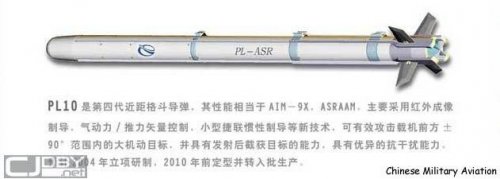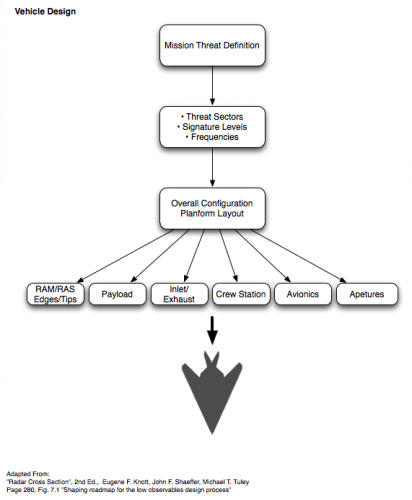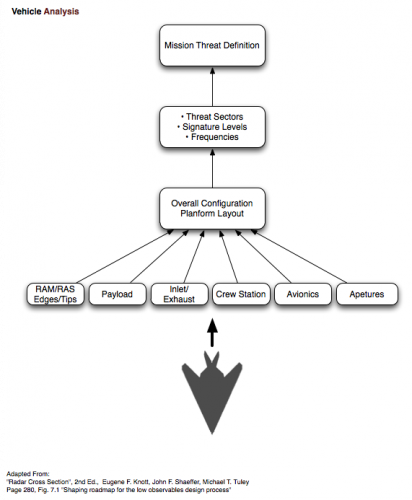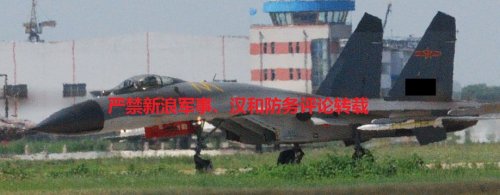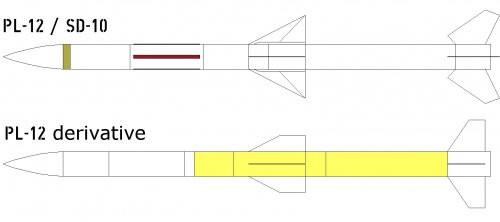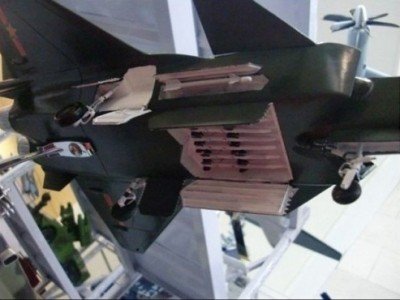You are using an out of date browser. It may not display this or other websites correctly.
You should upgrade or use an alternative browser.
You should upgrade or use an alternative browser.
Chengdu J-20 pictures, analysis and speculation Part I
- Thread starter hantang
- Start date
- Status
- Not open for further replies.
- Joined
- 2 January 2006
- Messages
- 3,828
- Reaction score
- 5,132
Yes ... reportedly this new missile is the "missing" PL-10 or PL-ASR
http://cnair.top81.cn/missile.htm
Deino
http://cnair.top81.cn/missile.htm
Deino
Attachments
- Joined
- 17 October 2006
- Messages
- 2,393
- Reaction score
- 1,197
Deino said:LowObservable said:Has anyone seen the right-hand bay door open?
Because you'd put both side bays on an FSD aircraft, or a Y-aircraft, but it would be a waste of money on an X-plane.
Yeppp ...
Thanks. A hefty piece of evidence against the "it's an X-plane, won't be in service before 2025" crowd.
Study of VLO potential of the J-20 design...
A Preliminary Assessment of Specular Radar Cross Section Performance in the Chengdu J-20 Prototype Air Power Australia Analysis 2011-03
4th July 2011A Monograph by Dr Michael J Pelosi, MBA, MPA,
Dr Carlo Kopp, SMAIAA, SMIEEE, PEng
http://www.ausairpower.net/APA-2011-03.html
A Preliminary Assessment of Specular Radar Cross Section Performance in the Chengdu J-20 Prototype Air Power Australia Analysis 2011-03
4th July 2011A Monograph by Dr Michael J Pelosi, MBA, MPA,
Dr Carlo Kopp, SMAIAA, SMIEEE, PEng
http://www.ausairpower.net/APA-2011-03.html
"In conclusion, this study has established through Physical Optics simulation across nine frequency bands, that no fundamental obstacles exist in the shaping design of the J-20 prototype, which would preclude its development into a genuine Very Low Observable design."
- Joined
- 17 October 2006
- Messages
- 2,393
- Reaction score
- 1,197
The study is pretty noncontroversial. If you read it, it doesn't say ZOMG PANIC CHINESE STEALTH IS HERE. It concludes that with some fixes and RAM the aircraft could be stealthy to a reasonable level (which is not hard to guess, given its resemblance to an F-22) but that we don't know enough about material and detail technology to say when it will be so.
- Joined
- 6 August 2007
- Messages
- 3,894
- Reaction score
- 5,978
LowObservable said:The study is pretty noncontroversial. If you read it, it doesn't say ZOMG PANIC CHINESE STEALTH IS HERE. It concludes that with some fixes and RAM the aircraft could be stealthy to a reasonable level (which is not hard to guess, given its resemblance to an F-22) but that we don't know enough about material and detail technology to say when it will be so.
I have some issues with their conclusions based on the methods used. Pay careful attention to the sections "Aircraft Model Features and Limitations" and "What the Simulation Does Not Demonstrate".
Optical methods are fine for simulating specular reflections. For the lower end of low (i.e. NATO A-E, 10-~3000mhz) and higher end of high (NATO I and up, 8000mhz+), other methods are more appropriate. Optical methods are fast, but are only useful for high level configuration analysis (which this is) because dominant reflectors in these ranges can be missed.
In all bands, however, model fidelity and accuracy is a factor.
These things are pointed out in those two sections (as well as other items). The simulation itself is not flawed, but it does not support all of the conclusions. In particular, the statement:
"the design would present very good potential for robust Very Low Observable performance in the S-band and above"
(S-band being NATO E/F band, 2000-4000mhz. Pretty chart here: http://www.radartutorial.eu/07.waves/wa04.en.html ). Because this is a simulation using optical methods with a simple configuration model, accuracy in these frequencies would be low. Shaping is the dominant factor determining RCS (even when the vehicle is coated with Sham-wow), the simple model does not include shaping features which would drive reflection in these bands, and the simulation method is not able model reflection in these bands well.
That said, part of the conclusion is supported by the capabilities of the simulation:
"If the production J-20 retains the axisymmetric nozzles and smoothly area ruled sides, the aircraft could at best deliver robust Very Low Observable performance in the nose aspect angular sector."
Yup, that's about right (for specific bands). For very high frequencies, and very low frequencies, that may not be true.
Kryptid
ACCESS: Secret
- Joined
- 12 March 2009
- Messages
- 282
- Reaction score
- 52
The J-20 certainly could be stealthy, but we know that stealth is determined by more than just what you can see in a photograph. As Dan Raymer said in his autobiography, there are certain specifics of stealth design that you only learn to do right through experience (he mentions antennas, formation lights, and doors). That was one area where North American Rockwell fell behind in when compared to Lockheed Martin and Northrop Grumman during the ATF design phase, for example.
- Joined
- 6 August 2007
- Messages
- 3,894
- Reaction score
- 5,978
Kryptid said:The J-20 certainly could be stealthy, but we know that stealth is determined by more than just what you can see in a photograph. As Dan Raymer said in his autobiography, there are certain specifics of stealth design that you only learn to do right through experience (he mentions antennas, formation lights, and doors). That was one area where North American Rockwell fell behind in when compared to Lockheed Martin and Northrop Grumman during the ATF design phase, for example.
Yes and no. Since shaping is *always* the dominant factor in RCS, the most important things CAN be seen in a photograph. You just need a good photograph (or, a lot of them from different perspectives at different resolutions, and a good grasp of linear algebra). From a photograph, or set of photographs, you can build an accurate model of the vehicle, and from that compute much of the vehicle's RCS. This is what ausairpower did, though the fidelity of their model leaves much to be desired. The optical methods of RCS calculation they used only compute the specular reflections. They can't compute returns from surface traveling waves, creeping waves, edge diffraction, etc. For some bands, those things are less of a factor than others.
But Raymer's point is a good one. In the ausairpower paper they point out that they make a lot of assumptions, in particular about the inlets, the exhausts, and the apertures. The F-22 radome was one of the most challenging parts of the whole program, and it took a while to get right. A LO radome is far from trivial, and without that you have a giant reflector on your nose (for certain bands).
As your overall RCS gets lower from shaping, the small things like formation lights and hinges become dominant sources of reflection (or eddy currents, or scattering, etc.). If you are not targetting that much of a reduction, you may not worry about those things as much. Bird Of Prey is a good example of this. From a distance it does not look like much. But the RCS of the BoP shape was so low that fasteners, hinges, and airframe flex were addressed because they were large contributors to the RCS at that point. The RCS of a given shape may not be low enough that things like formation lights are a concern - you could say that's what differentiates a VLO design from a LO or "RO" design.
Design of a reduced RCS vehicle starts with defining the threat you are up against. In the case of HAVE BLUE, for instance, the threat was defined as the GUN DISH system used by several Soviet AAA systems, notably the ZSU-23. It uses a specific set of frequencies, from specific aspect angles (you're always going to be somewhere above it, etc.). Those things drive the shaping of your vehicle. Coatings, apertures, canopies, missing specific equipment like bomb bays, those come last. Then poof, you have your configuration!
This is illustrated well on page 279-280 of "Radar Cross Section" by Eugene F. Knott, John F. Shaeffer and Michael T. Tuley.
http://books.google.com/books?id=j7hdXhgwws4C&lpg=PA280&pg=PA280#v=onepage&q&f=false
Signature analysis is the same steps, but the flow is reversed. You *start* with the vehicle, and work backwards. From the overall configuration and planform you can simulate the RCS of the vehicle in different bands, from different aspects, in different configurations (this is what ausairpower attempted to do). From that data you can work out what threats the vehicle was designed to counter.
Attached are two charts based on Knott, Shaeffer, Tuley that reflect this (no pun intended). The first shows the design process, the second the analysis process.
Attachments
- Joined
- 18 March 2008
- Messages
- 3,529
- Reaction score
- 983
Triton said:Uploaded by houshanghai on 06/26/2011
Well these images should be the death knell of the J-20 is a bomber argument. Basically a clone of the F-22’s weapons bay arrangement with the same limited depth in the main bays. Two IR lock on before launch dogfight missiles and six long range missiles. The canard configuration and large door opening to the top of the side bays will ruin their seeker head field of view in a dogfight. Looks like design by committee.
- Joined
- 6 August 2007
- Messages
- 3,894
- Reaction score
- 5,978
Abraham Gubler said:Well these images should be the death knell of the J-20 is a bomber argument. Basically a clone of the F-22’s weapons bay arrangement with the same limited depth in the main bays. Two IR lock on before launch dogfight missiles and six long range missiles. The canard configuration and large door opening to the top of the side bays will ruin their seeker head field of view in a dogfight. Looks like design by committee.
It would be a really interesting way to carry an ASBM, or YJ-12.
- Joined
- 18 March 2008
- Messages
- 3,529
- Reaction score
- 983
quellish said:It would be a really interesting way to carry an ASBM, or YJ-12.
These missiles are huge. Dorsal pylon?
- Joined
- 17 October 2006
- Messages
- 2,393
- Reaction score
- 1,197
AG - I'm not sure I agree with you one hundred per cent on your analysis work, there.
If the side missiles have an LOBL role, which they do, since there's not much point in having them otherwise, they'll be on a trapeze that swings out and forward and the door-canard masking in the front hemisphere will be limited.
As for weapons, I don't know that we ever expected two Mk84s. I don't see anything that would preclude this design from having a deeper section to the belly bays inboard and between the ducts. But is that necessary? I'd be thinking ARMs, not necessarily carrier-sinkers.
If the side missiles have an LOBL role, which they do, since there's not much point in having them otherwise, they'll be on a trapeze that swings out and forward and the door-canard masking in the front hemisphere will be limited.
As for weapons, I don't know that we ever expected two Mk84s. I don't see anything that would preclude this design from having a deeper section to the belly bays inboard and between the ducts. But is that necessary? I'd be thinking ARMs, not necessarily carrier-sinkers.
- Joined
- 18 March 2008
- Messages
- 3,529
- Reaction score
- 983
LowObservable said:If the side missiles have an LOBL role, which they do, since there's not much point in having them otherwise, they'll be on a trapeze that swings out and forward and the door-canard masking in the front hemisphere will be limited.
If so the trapeze will need a lot of length to provide the forward displacement to clear both the big single piece door and the forward of the canard. Noteworthy that on the F-22 the forward end of the AIM-9X does not displace forward of the weapons bay and it is sharply canted outwards to increase seeker angular view. It is actually possible on the J-20 that the big single piece door could hold the rail for the missile a la the second station on the F-35. In which case they save weight by ditching a trapeze but only have a forward and downwards field of view for their seeker head.
LowObservable said:As for weapons, I don't know that we ever expected two Mk84s. I don't see anything that would preclude this design from having a deeper section to the belly bays inboard and between the ducts. But is that necessary? I'd be thinking ARMs, not necessarily carrier-sinkers.
The ducts will have to displace inwards thanks to the side bays. There isn’t going to be much room in their for a deep weapons bay. Especially if they want some out of wing fuel tankage.
Uploaded by houshanghai on July 01, 2011
http://youtu.be/3AIxJefSJIk
http://youtu.be/3AIxJefSJIk
Uploaded by houshanghai on July 01, 2011
http://youtu.be/0hUV6OwsGyI
http://youtu.be/0hUV6OwsGyI
Uploaded by houshanghai on July 01, 2011
http://youtu.be/2_0AVWIbf3M
http://youtu.be/2_0AVWIbf3M
LowObservable said:I'd be thinking ARMs, not necessarily carrier-sinkers.
But would the planning committee of the PLA?
- Joined
- 18 March 2008
- Messages
- 3,529
- Reaction score
- 983
Gridlock said:But would the planning committee of the PLA?
These arguments have been made before: this thread and topic is cyclic thanks to the many new comers who don't read the history. The PLA does not have an exclusive anti carrier fetish as some like to portray it in the hugely distorted view in many parts of the west. From their force structure the legacy system now due for replacement is the FINBACK (Shenyang J-8) which is a fighter interceptor. Having lots of anti ship strike is not going to do them much good if RoCAF F-16s and USN F-18s shoot them all down so they need to contest air superiority to achieve their access denial mission.
The design of the J-20 screams air to air except for an unsubstantial perception that it is a 100,000 lbs aircraft. This belief has lead some to assume it is a F-111 type strike aircraft. But it lacks many of the features required for this mission and has many features that only make sense for air to air. One of which is the bomb bay is not positioned and sized to carry large and heavy air to ground stores.
Abraham Gubler said:..has many features that only make sense for air to air. One of which is the bomb bay is not positioned and sized to carry large and heavy air to ground stores.
If you're going for a capital ship you might as well use a store that's small and punchy, which was the speculation I was aiming for - not that is is an F-111, but still a strategic platform is a possibility.
Edit: You also make the very short-term assumption that all capital ships belong to the same country.
A new missile (for me at least) that has appeared on a J-11 (it looks like it's in PLANAF grey?)


Now I don't think it's PSed, and I also think it's new, but I'm not sure whether it's a completely new model or a development of PL-12 or PL-11, though I'd imagine it's the former.
PL-12C is supposed to be the "compact" version, but the drawing/timeline we saw a while ago showed it only had foldable rear fins where as this one looks more like the compact AMRAAM with clipped fins rather than folding ones. It's possible they chose to go for the AMRAAM approach rather than fold fins.
So obviously if this thing's real we'll see them in J-20.


Now I don't think it's PSed, and I also think it's new, but I'm not sure whether it's a completely new model or a development of PL-12 or PL-11, though I'd imagine it's the former.
PL-12C is supposed to be the "compact" version, but the drawing/timeline we saw a while ago showed it only had foldable rear fins where as this one looks more like the compact AMRAAM with clipped fins rather than folding ones. It's possible they chose to go for the AMRAAM approach rather than fold fins.
So obviously if this thing's real we'll see them in J-20.
- Joined
- 2 January 2006
- Messages
- 3,828
- Reaction score
- 5,132
I agree with You, this one looks like the long rumoured PL-12C even if it looks different to the chart we know.
Besides that here's another photo - now on a standard PLAAF J-11B in contrast to the PLANAF BH above - (seems to be the completeone from the cut-out part above).
Deino
Besides that here's another photo - now on a standard PLAAF J-11B in contrast to the PLANAF BH above - (seems to be the completeone from the cut-out part above).
Deino
Attachments
- Joined
- 2 January 2006
- Messages
- 3,828
- Reaction score
- 5,132
Blitzo said:A new missile (for me at least) that has appeared on a J-11 (it looks like it's in PLANAF grey?)
....
Quite interesting, Huitong calls this missile PL-1X as a new missile:
It was reported that 607 Institute has been developing a new activing radar homing AAM comparable to American AIM-120D (dubbed PL-15?). Recent photos showed a new type of missile being tested onboard a J-11B fighter. Compared to PL-12 of the same class, the missile features stablizing fins and tailfins with reduced wingspans, suggesting its design is optimized for internal carriage by the 4th generation fighter such as J-20. PL-1X may also features improved guidance system (including duplex datalink and new active/passive dual mode seeker with enhanced ECCM capability) as well as a bigger motor which gives it a longer range (~100km?). There was a speculation that PL-1X is actually a new anti-radiation AGM comparable to American HARM, but this has yet to be confirmed.
http://cnair.top81.cn/missile2.htm#PL-1X
Deino
Regarding the IR field of view while on rails, it appear to me that the forward edge of the side bay on the J-20 is close to level with the forward edge of the root of the canard. If this is the case, then the missile only need to swing forward on trapeze a little bit till its seeker head clear the forward edge of the door, and then it will have a nearly 60-70 degree off-bore view straight up. I don't think this is very restricting at all. If you want to lock on target that's actually directly above or even above and behind you, you probably need lock-on after launch capability anyway.
In any case, given that this fighter won't be in service for at least another 6-7 years, I don't think it is unreasonable on Chinese part to suppose that data rate between missile and plane can become so high that when J-20 enters service, the aircraft can always securely cue the missile's seeker remotely, so it's IR missile will always launch before lock-on. If you have a wide-angle imaging focal plane array on the missile and the ability to streaming HD video at high frames rate to and from the missile, along with a imposed reference grid, and any missile-aircraft displacement correction, then you can always tell the missile remotely how to steer to bring the desired target into view and which target the missile is seeing on its own array to go after. You probably have all the technology required for the data transmission part if you have any high end home video streaming capability.
In any case, given that this fighter won't be in service for at least another 6-7 years, I don't think it is unreasonable on Chinese part to suppose that data rate between missile and plane can become so high that when J-20 enters service, the aircraft can always securely cue the missile's seeker remotely, so it's IR missile will always launch before lock-on. If you have a wide-angle imaging focal plane array on the missile and the ability to streaming HD video at high frames rate to and from the missile, along with a imposed reference grid, and any missile-aircraft displacement correction, then you can always tell the missile remotely how to steer to bring the desired target into view and which target the missile is seeing on its own array to go after. You probably have all the technology required for the data transmission part if you have any high end home video streaming capability.
- Joined
- 24 January 2006
- Messages
- 1,322
- Reaction score
- 470
OK. Who else finds it amusing that the new missile looks like Taiwan's TC-2.
;D
Given the similarity to the PL-12 I doubt that this is a wholly new design. Although, they may very well redesignate it anyway if it does feature a new seeker. It appears to use the same launch rail as the PL-12/J-11B combination, making the weapon appear to be pretty much the same size as the "baseline" PL-12. The major difference apart from fin shape is the position of the mid-body fins: they've been moved back. If a new motor is featured, anything bigger would necessitate the aforementioned new (or even repackaged) guidance system. Whether or not this means a new type designation within PLA channels, I don't know. Although based primarily on a few poor-quality photos, I'd wager that the missile still owes a lot to the "baseline" PL-12, although that's just educated guesswork at this stage.
;D
Given the similarity to the PL-12 I doubt that this is a wholly new design. Although, they may very well redesignate it anyway if it does feature a new seeker. It appears to use the same launch rail as the PL-12/J-11B combination, making the weapon appear to be pretty much the same size as the "baseline" PL-12. The major difference apart from fin shape is the position of the mid-body fins: they've been moved back. If a new motor is featured, anything bigger would necessitate the aforementioned new (or even repackaged) guidance system. Whether or not this means a new type designation within PLA channels, I don't know. Although based primarily on a few poor-quality photos, I'd wager that the missile still owes a lot to the "baseline" PL-12, although that's just educated guesswork at this stage.
a while ago there was an article about a new missile which had completed development -- it sounded like propaganda, but with these photos... i dunno.
http://english.peopledaily.com.cn/90001/90776/90786/7385767.html
Also, huitong said this might be an ARM instead... I'm thinking if it could be both an MRAAM and ARM like the Joint Dual-Role Air Dominance Missile the USAF is thinking of?
http://english.peopledaily.com.cn/90001/90776/90786/7385767.html
China successfully develops new-generation air-to-air missile:Thursday, May 19, 2011: China has achieved what some foreign experts once thought was impossible it has independently developed a next-generation air-to-air missile without assistance from foreign specialists or borrowed technology.
Designed by Fan Huitao, the deputy director of the Air-to-Air Missile Research Institute under the Aviation Industry Corporation of China, the missile, known as the "Key Model," successfully passed the designed type approval test and achieved an excellent result, with all seven missiles hitting their targets.
Its successful development indicates that China already fully possesses the ability to independently develop internationally-advanced air-to-air missiles. It is a historic breakthrough in China's air-to-air missile development and has met the Chinese Air Force's requirement for the model to be designed, produced, delivered and made combat effective within one year. The new missile offers the military and country another trump card.
The Key Model is an international-advanced AAM model. It is a secret weapon for gaining air superiority. It plays a crucial role in reinforcing the power of national defense and strengthening the influence of China.
However, it is very hard to develop and only a few developed countries around the world possess such a capability. The complicated system of the model and the high-grade, high-precision and advanced technologies needed to develop it has never been seen in the development of other models.
Foreign military experts once believed that employing foreign specialists as chief designers was the only way for China to succeed. Even some Chinese experts believed that the success rate of developing this kind of missile was not high when relying only on the current technical conditions of China. This was because China did not have any documents to refer to and could not use a shortcut.
The successful completion of the missile is the culmination of Fan Huitao's career in the aviation industry. After Fan graduated from Northwestern Poly-technical University with a major in aircraft engines in April 1986, he went to Luoyang and devoted himself to the field of air-to-air missiles.
In 2000, Fan took over as the chief model designer and began to lead a group in researching China's new-generation air-to-air missile.
Also, huitong said this might be an ARM instead... I'm thinking if it could be both an MRAAM and ARM like the Joint Dual-Role Air Dominance Missile the USAF is thinking of?
- Joined
- 3 June 2011
- Messages
- 18,337
- Reaction score
- 12,240
ELP said:It only has to be stealthy enough to reduce the PK of the AMRAAM to that of a Vietnam-era Sparrow. Once the glass-jaw of the great-white hope is minimized; you will have problems.
"Once the glass-jaw of the great-white hope is minimized; you will have problems."
What do you mean by that specifically?
latenlazy
I really should change my personal text
- Joined
- 4 July 2011
- Messages
- 245
- Reaction score
- 37
I presume this study basically provides an "upper bound" of sorts for how stealthy the J-20 can be?quellish said:LowObservable said:The study is pretty noncontroversial. If you read it, it doesn't say ZOMG PANIC CHINESE STEALTH IS HERE. It concludes that with some fixes and RAM the aircraft could be stealthy to a reasonable level (which is not hard to guess, given its resemblance to an F-22) but that we don't know enough about material and detail technology to say when it will be so.
I have some issues with their conclusions based on the methods used. Pay careful attention to the sections "Aircraft Model Features and Limitations" and "What the Simulation Does Not Demonstrate".
Optical methods are fine for simulating specular reflections. For the lower end of low (i.e. NATO A-E, 10-~3000mhz) and higher end of high (NATO I and up, 8000mhz+), other methods are more appropriate. Optical methods are fast, but are only useful for high level configuration analysis (which this is) because dominant reflectors in these ranges can be missed.
In all bands, however, model fidelity and accuracy is a factor.
These things are pointed out in those two sections (as well as other items). The simulation itself is not flawed, but it does not support all of the conclusions. In particular, the statement:
"the design would present very good potential for robust Very Low Observable performance in the S-band and above"
(S-band being NATO E/F band, 2000-4000mhz. Pretty chart here: http://www.radartutorial.eu/07.waves/wa04.en.html ). Because this is a simulation using optical methods with a simple configuration model, accuracy in these frequencies would be low. Shaping is the dominant factor determining RCS (even when the vehicle is coated with Sham-wow), the simple model does not include shaping features which would drive reflection in these bands, and the simulation method is not able model reflection in these bands well.
That said, part of the conclusion is supported by the capabilities of the simulation:
"If the production J-20 retains the axisymmetric nozzles and smoothly area ruled sides, the aircraft could at best deliver robust Very Low Observable performance in the nose aspect angular sector."
Yup, that's about right (for specific bands). For very high frequencies, and very low frequencies, that may not be true.
The final production J-20 is at least 5 years away and could yet be substantially different from what has been seen hitherto. So I wouldn't say this represent any definitive upperbound on the J-20's stealthiness. I personally suspect there will be major revision to the after body prior to series production. For one thing, the WS-15 engine supposedly being developed to provide the sort of T/W expected of a Gen 5 fighter has to be significantly fatter than the AL-31 the prototype carries. I also expect much evolved stealth treatment to the nozzles compare to the current almost standard AL-31 nozzle.
The fact that this plane attempts to be stealthy while featuring many airfoils and a all moving canard suggests to me that the FBW system would be extremely tightly integrated into any mission management system so as to automatically manage the deflection on all control surfaces to minimize radar return given current threat situation and mission objective before the plane is discovered.
The fact that this plane attempts to be stealthy while featuring many airfoils and a all moving canard suggests to me that the FBW system would be extremely tightly integrated into any mission management system so as to automatically manage the deflection on all control surfaces to minimize radar return given current threat situation and mission objective before the plane is discovered.
- Joined
- 24 January 2006
- Messages
- 1,322
- Reaction score
- 470
New missile compared with the baseline PL-12. The new missile does not appear to be longer or of increased diameter, and appears to have a reduced tail span. It does also appear to contain a larger rocket motor and reconfigured guidance package, but the warhead assembly appears to be unchanged, albeit slightly relocated.
Attachments
- Joined
- 22 April 2012
- Messages
- 2,258
- Reaction score
- 2,309
SOC,
Thanks for the analysis, are you planning on writing a longer piece about this new derivative?
Thanks for the analysis, are you planning on writing a longer piece about this new derivative?
- Joined
- 24 January 2006
- Messages
- 1,322
- Reaction score
- 470
I extrapolated a rough fin-span based on the diameter of the missile body. It's not blisteringly acurate but it should be close, I could firm up a few things if we got a purely side-aspect image. Bear in mind that you're looking at the missile in the photos at an angle as it's rotated to sit on the pylon, so the control surfaces will always look a bit smaller.
There will be a bit about the weapon in the July issue of I&A.
There will be a bit about the weapon in the July issue of I&A.
- Joined
- 24 January 2006
- Messages
- 1,322
- Reaction score
- 470
From what I gather the aft fins are of reduced span, albeit not all that much. As to why, who knows? One idea is that they do in fact fold, but that they aren't folding when carried externally. Or that the J-20's variant will have folding fins, and the external carriage model will not.
- Joined
- 27 March 2006
- Messages
- 1,873
- Reaction score
- 1,621
saintkatanalegacy
Little Miss Whiffologist
- Joined
- 31 March 2009
- Messages
- 718
- Reaction score
- 17
something bugs me about the position of the rear edge of the main weapons bay
edit: refer to post 361
the bays are longer and the rear edge has smaller sawtooths
edit: refer to post 361
the bays are longer and the rear edge has smaller sawtooths
- Status
- Not open for further replies.
Similar threads
-
-
-
Shenyang FC-31 demonstrators / J-35 naval fighter / J-35A land-based version
- Started by Foxglove
- Replies: 1K
-
-

